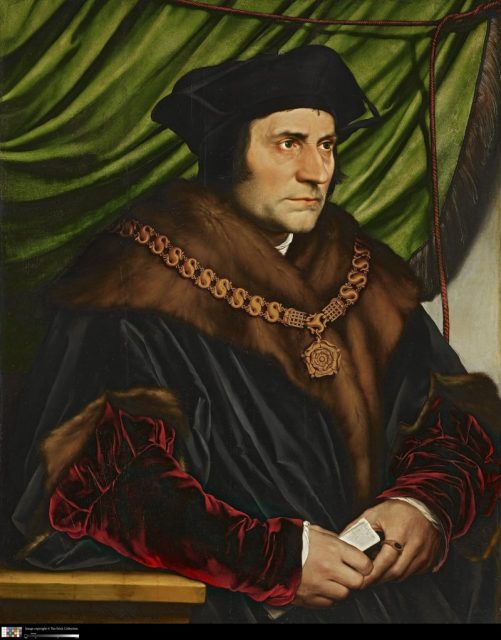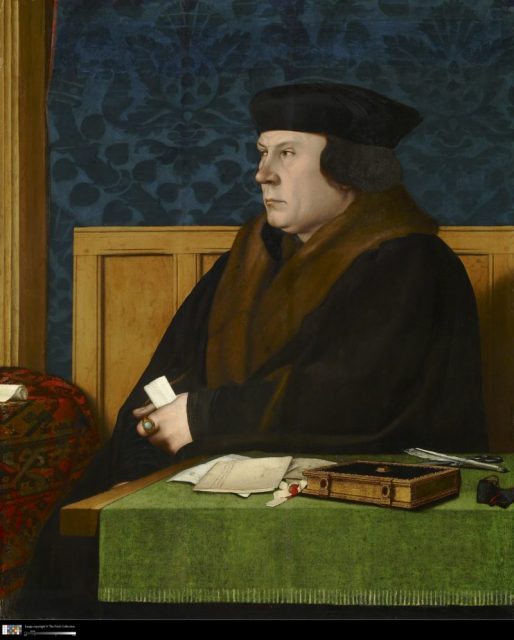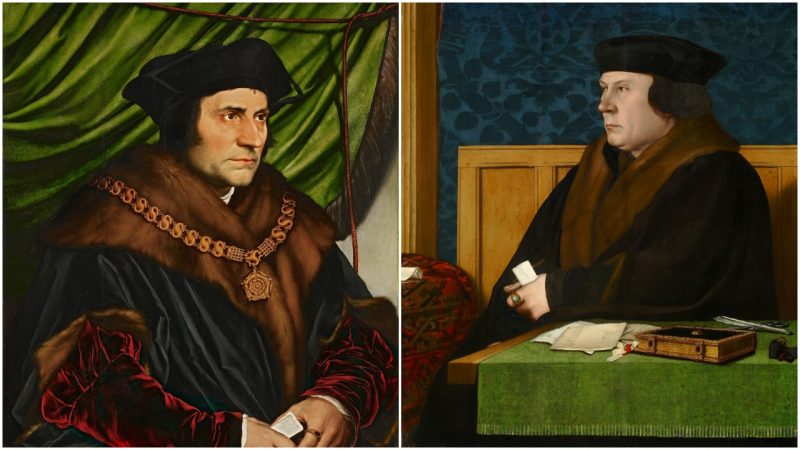Thomas Howard, Duke of Norfolk, was one of the least eloquent men in the court of Henry VIII but he was the man who put it best: “The anger of the prince means death.” Two statesmen who found that truth on the scaffold were Sir Thomas More and Thomas Cromwell.
Sir Thomas More, a devout Catholic and philosopher, lawyer, and royal councilor, would not compromise his values and sign the oath of supremacy to Henry VIII as head of the church. The former Lord Chancellor to the King approached his execution on July 6, 1535, with the wit he possessed throughout his life. At the foot of the rickety steps to the scaffold, he said to the Lieutenant: “Pray, Sir, see me safe up; and as to my coming down, let me shift for myself.” Moments before the awe swung, he declared to the rapt crowd: “I die the King’s faithful servant, but God’s first.”
The man who had engineered More’s early arrest in 1534 and continued to press for his destruction was Thomas Cromwell, the new leading councilor of Henry VIII and enemy of the Catholic Church. But despite his devoted service to the king’s needs and desires, Cromwell fell out of favor, perhaps due to his arranging Henry VIII’s fourth marriage to Anne of Cleves, whom the king loathed, and on July 28, 1540, he was executed on Tower Hill.
How people imagine Sir Thomas More and Thomas Cromwell, these two very different ministers to Henry VIII, has something to do with their famous portraits by Hans Holbein the Younger, the German artist whose work defined the Tudor era. In their expressions, their clothes, their gripping of papers, we see something of their essence.
However, if you want to gaze upon the original paintings, you do not go to the National Portrait Gallery in London, or to any other museum in England. Cromwell and More are not in private collection in England, either. Nor are they to be found in Europe, for that matter.
No, you need to head over to 70th Street and Fifth Avenue, in New York City. Inside a beautiful mansion built right before World War One called The Frick Collection, you will find the originals of Cromwell and More

Sir Thomas More, 1527 Oil on panel 29 ½ x 23 ¾ inches The Frick Collection, New York Photo: Michael Bodycomb
The Tudor portraits were created with live sitters. Hans Holbein’s connection to each man went deeper than a portrait commission. The artist might have lived with Sir Thomas More for a time. After More’s execution, Holbein was favored by Anne Boleyn, and he designed some jewelry and coronation decorations for the stylish queen in addition to portraits (Henry VIII later ordered her portraits destroyed). Cromwell, in turn, patronized Holbein after the fall of Anne Boleyn, but some believe it was Holbein’s portrait of Anne of Cleves, leading Henry to want to marry her, that led to the crisis of Cromwell. What a tumultuous time to be a court painter!
Today the two Tudor statesmen’s portraits hang in the Living Hall of the Frick Collection, a lushly masculine space of oak-paneled walls, 18th century furniture, and ceramics and bronzes that is supposed to have been kept unchanged since Henry Clay Frick occupied his house in the early 20th century.
Frick’s feelings about the two men may have much to do with how he felt about power and rivalry. He knew a great deal about both.
Yes, Frick was one of the premier collectors of the Old Masters in all of America. But just as there were many sides to Thomas Cromwell and Thomas More, there is much more than art appreciation to Frick. In fact, he was for a time widely known as “the most hated man in America.”
The Frick Collection is considered one of New York City’s chief art treasures, filled with paintings by Rembrandt, Vermeer, Fragonard, Goya, Bruegel, Gainsborough, Van Dyck, Titian and Turner. It was Frick who personally bought these paintings, in a frenzy of purchases that ended during World War I.

Oil on oak panel (cradled) 30 7/8 x 25 3/8 inches
The Frick Collection, New York Photo: Michael Bodycomb
To learn why he was so despised, we need to now head west, to Pennsylvania, where Frick lived for the early part of his life. His parents were rural Mennonites. At the age of 21, he formed a partnership with cousins and friends called Frick Coke Company–using a special oven, they turned coal into coke for steel manufacturing. By the early 1880s, Frick controlled most of the coal output in the entire state.
Frick took his place on the national stage when he became partners with Andrew Carnegie of the Carnegie Steel Company. In 1892, the violent Homestead Steel Strike, which Frick provoked as a way to break the union, earned him the nickname of most hated man. Frick brought in 300 Pinkerton guards after the steelworkers went on strike, leading to an epic all-day battle leaving 16 men dead and many more wounded. The governor was forced to call in 8,000 militia to restore order.
Alexander Berkman, an anarchist and lover of Emma Goldman, tried to assassinate Frick in his Pittsburgh office. Carnegie, who didn’t want the labor wars to tarnish his reputation, was in Europe during the strike but approved of breaking it from afar. After repelling would-be assassin Berkman, who was armed with a knife and a gun, Frick cabled Carnegie: “Shot two times…no necessity for you to come home. I am still in shape to fight the battle.”
Frick bought the painting of Sir Thomas More in 1912 and the one of Thomas Cromwell in 1915. Frick very much wanted to buy Holbein’s painting of the beautiful Christina of Milan, whom Henry VIII tried but failed to marry, but it escaped his grasp.
Holbein was able to invoke the personalities of his subjects as few artists had before. They were wonderfully lifelike. Peter Ackroyd has written, “He illustrates his sitters in the light of some sudden but characteristic emotion, as if he had caught their thought on the wing.”
In 1901, Frick moved with his family to New York City. He was now a fabulously wealthy director of J. P. Morgan’s United States Steel Corporation, and he decided to spend some of his millions on art. This was a period of fierce competition for the finest paintings in Europe.
Frick was often going after the same masterpieces as Morgan, sugar magnate H.O. Havemeyer, and Boston philanthropist Isabella Gardner. Some of the oldest families in England were in a financial crisis, trying to hang onto their centuries-old estates. The art dealers who descended, representing American “robber barons,” could not have come at a better time for cash-starved aristocrats.
Frick had fallen out with Andrew Carnegie years earlier; lawsuits and acrimony followed. Although they did not speak, in their senior years, the two men both lived in New York City. Frick was building an art empire; Carnegie was writing books, funding libraries, and donating huge amounts of money to educational and artistic causes. Carnegie Hall on 57th Street, built in 1891, is one of the world’s premier concert venues.
When Frick couldn’t sleep, he roamed at night, looking at his art collection. His three favorite paintings were said to be Holbein’s Sir Thomas More, Giovanni Bellini’s St. Francis in the Desert, and Rembrandt’s last self-portrait.
In 1919, when Carnegie, 83, was dying, he sent a message to Frick seeking reconciliation. The note traveled from one man’s mansion to the other’s. “Yes, you can tell Carnegie I’ll meet him,” Frick responded. “Tell him I’ll see him in Hell, where we both are going.”
Months later, Carnegie and Frick were both dead.
In 1935, the Frick Collection opened its doors to the public. Art lovers could enjoy the exquisite sculptures and paintings, including the Holbein portraits of More and Cromwell, two men who underwent a different struggle in a different time, and yet now inhabit the same room, thanks to one of the most forceful men in all of America.
Nancy Bilyeau, the U.S. editor of The Vintage News, has written a trilogy of novels set in the court of Henry VIII: ‘The Crown,’ ‘The Chalice,’ and ‘The Tapestry.’ The books are for sale in the U.S., the U.K., and seven other countries. For more information, go to www.nancybilyeau.com.
